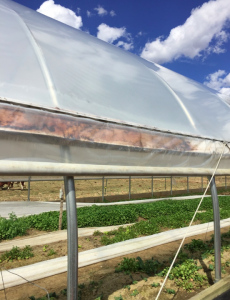June 5, 2016. Temperature 70 degrees F and heavy rains of up to 3/4 inch. Not outside the normal daily average of 52 to 74 degrees on this day and a daily rainfall likely to be within the monthly averages. However, the current weather can obscure us from thinking clearly about climate change aka global warming. Here’s a snapshot of what three farmers are saying about climate change and how they’re responding or not.
Our greenhouse has really beefed us up in terms of season extension. When people’s gardens are failing, we have a really good crop of tomatoes and cucumbers.
By getting crops in and out of the ground faster, short rotations, we can manage our cash flow.
Global warming is not that simple – some summers are warmer, but some some summers are cooler. We don’t have a new game plan. We haven’t changed our planting and harvesting schedules.
These anecdotes indicate that we don’t yet have a pattern to how farmers are responding to the Northeastern trend of warmer and wetter weather with more frequent heavy rain events. The variability of weather and the significance of site, soils, and infrastructure adds a lot of variables to the assessment as well as noise to the anecdotes. It may be only a matter of time until a clearer picture forms; as we talk to and share more experiences of Vermont farmers responding to longer-term weather trends, a pattern of adaption should start to emerge
As NOAA succinctly says, “the difference between weather and climate is a measure of time.” It reminds me of what one farmer told me, “you can’t call yourself a real farmer until you’ve farmed at least 20 seasons.” Years of practice, trial and error, we do know that many best practices go hand in hand with adaptation.
Adapting to climate change is playing the long game so in fact, our search for questions and adaptation answers has only really started.

